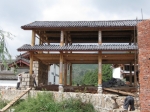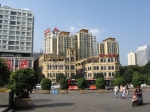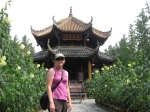We arrived in the beautiful karst region of Guiling/Yangshou. Jason had been to Yangshou a decade ago,and the town has become much more popular with tourists, with good reason. The scenery has stunning karst peaks, rice fields, bamboo groves and calm rivers. Yangshou has changed, with many more restaurants catering to westerners and the ubiquitous chains of McDonald’s and Kentucky Fried Chicken have moved in plus a multitude of other places offering “wood fired pizza”, hamburgers, spaghetti, western breakfast, etc. Additionally, as more Chinese move into the middle class and begin to take more vacations, the large Chinese tour groups flooding out of tour buses, led by flag-waving, bullhorn wielding guides have become a common component of the street scene in Yangshou. Read the rest of this entry »
Yangshou
26 09 2009Comments : 2 Comments »
Tags: nanning to hanoi, xingping, yangshou
Categories : China
Kaili
20 09 2009We left Yunnan and headed east to the city of Kaili in Guizhou province. The goal was to visit traditional Miao villages in the area. The Miao are linguistically and ethnically related to the Mong (Hmong) people who live in Thailand, Laos Vietnam, (and now agricultural areas known for growing strawberries in California). The Miao in China are known for their colorful clothing, ornate silver jewelry and embroidered baby packs.
Comments : Leave a Comment »
Tags: China roads, Kaili
Categories : China
Naxi Architecture
18 09 2009Yunnan province is known for the Naxi culture, but as city planners, we also were interested in Naxi architecture. Naxi traditional buildings are known for their quintessential tile roofs and wood framing, in addition to their resilience during earthquakes. Many of the traditional Naxi buildings withstood a recent earthquake, so the government has been encouraging builders to continue to use this style for new buildings. On a bike ride into the countryside north of Lijiang, we observed many new Naxi style buildings being built. Read the rest of this entry »
Comments : 1 Comment »
Tags: Naxi Architecture, Yunnan
Categories : Architecture, China
Lijiang and Tiger Leaping Gorge
16 09 2009We stayed in the small, historic town of Lijiang before doing an overnight at the Tiger Leaping Gorge. Lijiang is a well-travelled tourist spot, and the traditional portion of the town was used in the movie Crouching Tiger, Hidden Dragon for some of the shots. We also visited a small village north of town, and visited a fairly well known traditional doctor. Read the rest of this entry »
Comments : 2 Comments »
Tags: Lijiang, Tiger leaping gorge
Categories : Backpacking, China
Kunming
10 09 2009We made a quick stop on the main city of Kunming in Yunnan province after our train down to the southern part of China. It is another rapidly modernizing city in China, with a vibrant (to the point of being too much) redeveloped core mixing old and new buildings and structures. The city is known for nice tree lined streets, and as city planners, we noticed many recently redeveloped plazas and squares where large, mature trees were incorporated in the design and preserved, which is a nice change in China. Read the rest of this entry »
Comments : Leave a Comment »
Tags: Kunming
Categories : China
Emei Shan (Mt. Emei)
7 09 2009We went to the town of Leshan to get our visa extended and to spend a few days climbing on Emei Shan (Mount Emei). Emei Shan is one of the four sacred Buddhist mountains in China with many monasteries and temples on the way to the summit, which has been climbed by Buddhist pilgrims for many years. Leshan is also famous for a very large Buddha statue carved into a cliff along the river.
Comments : 2 Comments »
Tags: Emei Shan
Categories : China
Chengdu
3 09 2009We arrived in the big city of Chengdu. Here we visited a panda reserve, rode bikes around the city to various temples and parks, took a Sichuan cooking class, saw a theater performance and learned to play ma-jong. We had hoped to go to a large museum in the area, but we didn’t know there was only one bus a day and we missed it on our last day before leaving town. Chengdu is a nice city with good bike lanes and many parks. It is also very modern and you see many, many new buildings and shopping plazas under construction (similar to what we saw in Beijing and Xian).
Read the rest of this entry »
Comments : 2 Comments »
Tags: Chengdu
Categories : China







